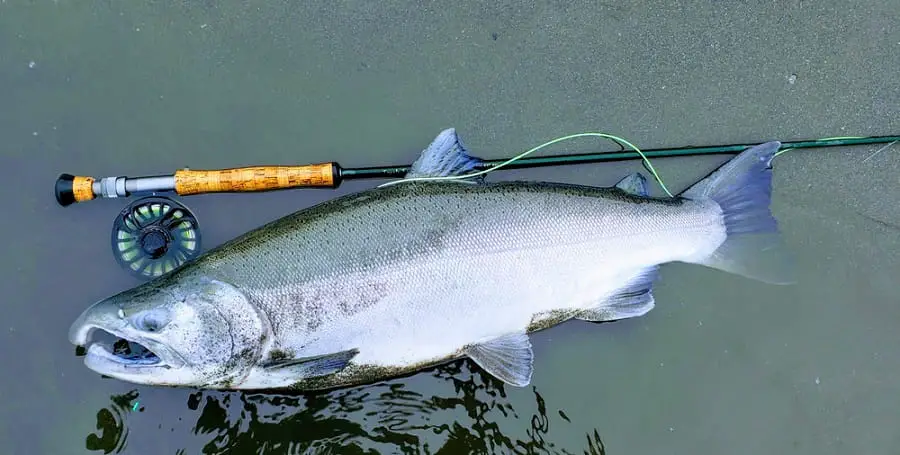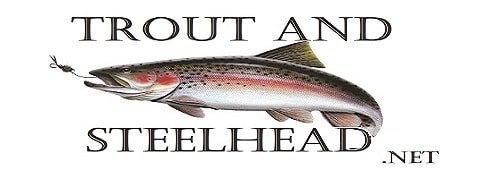Beach Fishing For Salmon: Gear And Methods

If you’re an angler who loves the thrill of fishing but doesn’t have access to a boat, don’t worry. Beach fishing for salmon is a good way to catch some salmon, and I will explain how and why! Some anglers also call this surf Fishing for salmon but they are basically the same thing.
You can still enjoy the excitement of catching Pacific salmon by beach fishing or surf fishing in beautiful British Columbia, and all along the Western Coastline from Northern California to Alaska.
This seasonal fishery is not only incredibly fun but also presents a challenge that will test an angler’s skills. By mastering the art of timing, honing my casting and retrieving techniques, and understanding the behavior of these giant migratory salmon, means I can successfully bring home some fresh salmon from the shore.
There are also opportunities to catch salmon from the beaches around the Great Lake Region.
Targeting Pacific Salmon from the Beach
Two species of Pacific salmon, pink salmon, and coho salmon, often swim close to the shore in the ocean. Some Chinook salmon will also roam close to shore while looking for their spawning rivers.
As they near the end of their adult phase in the ocean before entering spawning streams, these salmon aggressively feed along beaches where food is plentiful.
Their diet includes various prey such as herring, anchovy, needlefish, sandlance, stickleback, shrimp, and crab larvae.
Since they’re always hungry, enticing them with a lure or fly shouldn’t be a problem.
However, there are times when these fish seem uninterested in biting. In such cases, it’s crucial to determine what they are currently feeding on. With a wide range of prey available to them, matching the lure or fly to their preferred food source can make a significant difference in my success.
Choosing the Right Fishing Tackle
When it comes to beach fishing, there are two primary techniques: spincasting and fly fishing.
Unlike casting in a river, the key to beach fishing is achieving a good casting distance. It’s important to reach the schooling fish if I and my clients want to be more successful.
Since fish often feed far from the shore, I use a setup that allows me to cast a considerable distance.
The Best Rod For Salmon Fishing From Shore
A fishing rod measuring at least 9 feet long is recommended for this purpose. I will use either a spinning rod and reel or baitcasting rod and reel most of the time, however, when the salmon are in really close, I also use a fly rod.
My reels have a good quality line of at least 12lb to 15lb test.
The rod should also be capable of casting lures weighing up to 1/2oz. A longer rod is preferred by some anglers, and an 8’6″ to 10-foot rod suitable for salmon should suffice.
Remember, beach fishing involves repeated casting, and using an overly long rod can result in sore arms.
Best Fishing Reel For Beach Casting For Salmon
For the reel, choose a spinning or baitcasting reel in a size 3500 to 4500 that hold a lot of line.
When selecting a reel, ensure it is built to withstand saltwater conditions, and a good drag system. See Best Reels For Salmon.
Best Lines
Thinner lines allow for longer casts but are more susceptible to being cut by rocks and debris. Thicker lines are more durable but can compromise casting distance.
I often use braided lines with a 20 to 30-pound rating because they are ultra-thin yet still very strong and because I can get a lot more braided line on a reel.
Use A Landing Net
In most cases, a salmon-sized landing net with a long handle is necessary. Bring the fish into the shallow water and net it easier with a longer handle.
Lures For Catching Salmon From Shore
Lures like spoons, spinners, and crankbaits are the best when beach fishing from shore. For the best distance, casting spoons are the best lure for beach fishing or shore fishing for salmon.
Popular lures for beach salmon fishing include Little Cleos, Buzz bombs, Zingers, and other saltwater jigging lures. Freshwater spoons like Gibbs Croc spoons are also effective.
Two great spoons that I use and like are the Eppinger Daredevil spoons and the Mepps Syclops Spoon.
Beach fishing lures need to be denser, slim yet heavy, and designed for long-distance casting.
When targeting pink salmon, color selection is not crucial. Pink, orange, chartreuse, or plain silver lures all work well. For coho salmon, lures that resemble small baitfish such as needlefish, sandlance, and stickleback are commonly used.
The weight of the lure affects the casting distance. Lures weighing 3/8oz or more can be cast quite far but also tend to sink rapidly and are more prone to getting snagged.
Additionally, consider the water depth when selecting a lure. Freshwater spinners are also popular choices for coho salmon, but I often need to add extra weights to achieve the required casting distance.
Typically, a fixed weight is tied to the end of the main line, followed by 2 to 3 feet of leader, which is then tied to the spinner.
Beach Fishing With Fly Fishing
If enjoy fly fishing with an 8-weight fly fishing rod for beach salmon fishing. This size fly rod is heavy for Pinks, but it will help get more distance and will be good should if I encounter larger species like chinook salmon.
The rod should be 9 feet long with a fast action blank for achieving the necessary casting distance. Since the fishing depth is relatively shallow, a floating line will suffice.
A tapered leader measuring around 9 to 12 feet in length is commonly used, and the fly itself should be slightly weighted to gradually sink to the strike zone, use non-weighted streamer flies with a light sink tip or polyleader.
Effective beach salmon fishing flies mimic shrimp, crab larvae, minnows, sandlance, and needlefish. Streamer patterns that resemble baitfish are great.
When fly fishing, strip the fly in a more rapid manner to simulate the darting and suspending movements of shrimp or baitfish.
Season and Timing Considerations
Timing is a crucial factor for successful beach salmon fishing. The ocean is vast, so the fish are usually scattered unless they are actively feeding in a particular area. I begin searching for salmon on local beaches a few weeks before the salmon are expected to return to their natal streams to spawn.
Pink salmon can be found from late July to early September, while coho salmon are present along beaches in September and October. However, there are exceptions, such as the early runs of the Capilano River stock, which can be found along the beaches of West Vancouver in July and August.
Although early mornings are generally favorable for fishing, the tide plays a more significant role in determining the best time for fishing. Fish tend to become active near the shore during tidal changes.
Some locations yield excellent results during low tide, while others experience a surge of fish during high tide. Since every fishing spot is unique, the best way to find out is through experience and maintaining a fishing diary. Over time, I develop patterns and identify the most productive times.
How To Tell If The Salmon Are Near The Beach
Be observant before and while you fish.
Before I make my first cast, I take a moment to observe my surroundings. I step back and look for signs of fish in the water. They might be swimming close to the shore, and it’s essential not to spook them by wading too close.
Pink salmon often reveal their dorsal fins above the water, while baitfish leaping out of the water indicates that salmon are feeding beneath the surface.
Keep in mind that an abundance of jumping fish doesn’t guarantee a successful fishing trip. Staging fish near the estuary tends to jump frequently as they gather in a confined area.
These fish have likely encountered various lures in the past, so they may be more cautious.
Beach Fishing Techniques For Salmon
Casting straight out and reeling in is the basics, however, casting straight out, and taking 5 to 10 steps down the beach to cover the water is a good way of covering more water.
However, since the salmon are moving and swimming along the shoreline, standing and casting in the same area also works.
I have found that moving slowly and exploring while covering water has helped me locate more salmon.
The Cast And Retrieve
Once I have cast out the lure, start retrieving it immediately to keep it from sinking to the bottom.
The retrieval speed is generally faster than what I would use in a river. These salmon are aggressive feeders and won’t hesitate to chase down their prey. Regularly twitch and rip and pause the lure to add more action to the lure. I discuss the effectiveness of this in my articles:
If I am using a jigging-style lure, lift and drop the rod repeatedly while retrieving. Some anglers call these twitching jigs. I maintain tension on the line, even on the drop, so I can detect a bite and be ready to strike as soon as I feel it.
It’s advisable to wear a pair of waders when beach fishing. I often need to walk out from the shore to reach deeper spots and to net the fish. However, always be vigilant and watch for large waves approaching the shore to avoid any unexpected surprises. Surf fishing with waders can be risky.
If you decide to venture out to an exposed sandbar during low tide, be mindful of the tide level to ensure you don’t get stranded. Even though the water may appear shallow and calm, the current can be deceptively strong.
Promising Fishing Locations
Beach salmon fishing can be enjoyed near various towns along the East Coast of Vancouver Island, such as Port Hardy, Port McNeil, Campbell River, and Qualicum Beach. On the Sunshine Coast, you’ll find opportunities between Sechelt and Gibson.
There are also numerous locations around Vancouver where this fishery is available. Popular spots include Furry Creek in Howe Sound, Ambleside Beach in West Vancouver, and Cates Park in Deep Cove.
Productive beaches are often found near streams where salmon are expected to return for spawning.
Lastly, before you participate in this fishery, make sure you have a valid saltwater fishing license and a salmon conservation stamp. Familiarize yourself with the regulations of the area you plan to fish in, including any gear restrictions and daily retention limits for salmon.
Tight Lines
Graham

Graham, I have seen people “beach fishing” for Salmon in parts of Lake Ontario at the mouth of some tributaries, where they are casting out what looks to be eggs/skein, then just placing their rods in rod holders and waiting for a bite. What excactly is the technique here?
I know it as plunking. You can see it in this article https://troutandsteelhead.net/plunking-for-steelhead/